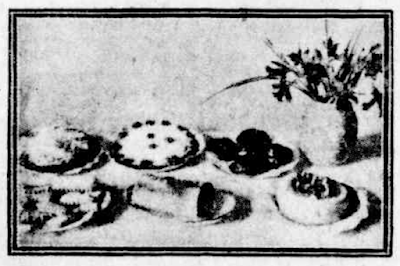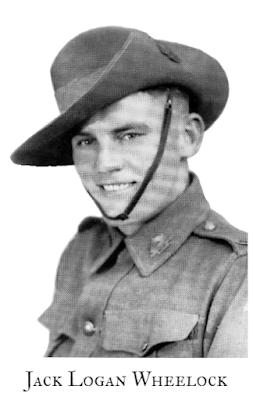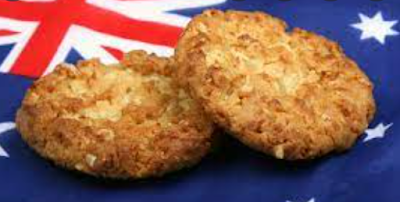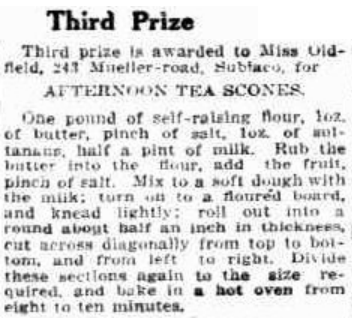Subiaco Women And Baking Recipes...(1916).
There was such a great response to the previous posts about the recipes published in newspapers from the women of Subiaco in the early years of the colony more have been included, this time from 1916. This blog post contains recipes from the women of Subiaco for recipes for baking including cakes, scones, biscuits and desserts.
In 1916, The Sunday Times continued to run their recipe (but had limited their household hints competition) offering prizes each week to women (and men) readers who shared their recipes and household hints. The entry coupon with the prizes for 1916 is copied below.
During 1916 there were nearly 80 recipes from the women (and men) of Subiaco that won prizes and received honourable mentions that were published during the year. They shared recipes for meat, puddings, cakes, preserves and sauces, vegetarian dishes and international dishes for example curries that began to appear. The women of Western Australia and Subiaco showed to be creative cooks and homemakers sharing a variety of recipes and household hints.
By 1916 World War One had been declared and was in its second year. Australian men and women were volunteering for the services and leaving to go overseas. There were food shortages as food was redirected to troops and labour shortages. Women experienced rationing at home and were encouraged to be self sufficient and have chickens and grow fruit trees and vegetables in the backyard.
The traditional spelling and grammar found in the published recipe has been maintained.
The articles and photographs are from Trove the databased of the National Library of Australia. No copyright infringement intended.
Second Prize.
Second prize is awarded to Mrs. C. Wilkinson, 13 Denis-street, Subiaco, for recipe for -
DATE CAKE.
Take the weight of two eggs in butter, sugar and flour, and 2 oz. of dates. Cream the butter and sugar and add the eggs, and then the flour. Place the mixture in a flat tin, and stone about a dozen dates, inserting an almond instead of the stone. Place them in rows in the mixture and bake for ten to fifteen minutes. When cold ice the top and cut into finger shapes.
Honorable Mention.
Cocoanut Cheesecakes. - Line tins with good pastry; three-parts fill with following mixture: - Beat two eggs lightly, place in a jar with an ounce of butter, 1/4 lb. of caster sugar, 3 oz of cocoanut, and a little grated lemon rind. Stand jar in a saucepan of boiling water over the fire, and stir until it thickens. Back unitl a pale fawn color for about 15 minutes. - Mrs T. Ellis, 37 Lawler-street, Subiaco.
The Sunday Times, 23 January 1916.
Third Prize.
Third prize is awarded to Miss Oldfield, 243 Mueller-road, Subiaco, for
AFTERNOON TEA SCONES.
One pound of self-raising flour, 1 oz. of butter, pinch of salt, 1 oz. of sultanans, half a pint of milk. Rub the butter into the flour, add the fruit, pinch of salt. Mix to a soft dough with the milk; turn on to a floured board, and knead lightly; roll out into a round about half an inch in thickness, cut across diagonally from top to bottom, and from left to right. Divide these sections again to the size, required, and bake in a hot oven from eight to ten minutes.
Honorable Mention.
Cake Trifle. - Cut the inner part out of a spongecake, leaving a wall and floor about 2 in. Fill the hollow with custard, sprinkle with blanched and split almonds, and dot with heaps, of red currant jelly. Beat up the whites of two eggs with sugar and little flavoring of vanilla, and pour over the trifle. - Miss A Powell, 173 Railway-road, Subiaco
The Sunday Times, 27 February 1916.
First Prize.
First prize is awarded to Mrs. M. Harding, 220 Barker-road, Subiaco, for recipe for
PASSION-FRUIT CAKE.
Take one dozen passion-fruit, 1/4 lb. butter, 1/2 lb. flour, 1/4 lb. sugar, two eggs, and one teaspoonful of baking powder. Open the passion fruit, put the pulp on a hair sieve with a little sugar, rub it through; beat the butter and sugar to a cream, drop in the eggs, and when well mixed pour in the juice of the passion fruit. Beat the flour and baking powder in with a spoon. Line two sandwich tins with buttered paper, divide the mixture, and pour it in; bake in a moderate oven for about half an hour. When cold spread the following mixture in between the layers; beat the white of one egg to a froth, add 3/4 lb. powdered sugar and the juice of two passionfruits. Spread the jelly on the cakes, and lay one above another. Spread the top of the cake either with whipped cream or white icing.
The Sunday Times, 5 March 1916.
Honorable Mention.
Apple Gateau. - Cover the bottom and sides of a Yorkshire pudding tin to the level of an inch with shortpaste, fill it with apples stewed, sweetened, and beaten smooth. Across the top form a diamond pattern with twisted narrow strips of paste. When nearly baked, brush over with sugar dissolved in a few drops of water. Boil the cores and parings of the apples in a little water, strain, then boil again with two tablespoonfuls of apricot jam or apple jelly, and when cool fill the diamond-shaped cavities with it. - Mrs. F. Truelove, 20 Morgan-street, West Subiaco.
The Sunday Times, 19 March 1916.
Recipe Supplied.
Victoria Sandwich. - Ingredients: Take two breakfast cups of flour, one teaspoonful cream of tartar, half teaspoonful carbonate soda, one cup sugar and three eggs, a little milk. Mode: Beat the whites and the yolks of eggs separately. When well beaten, mis together, adding the sugar and milk, then slowly pour into the dry ingredients, stirring till smooth. Bake in two sandwich tins in a moderate oven for 15 or 20 minutes. A delicious cream filling is made as follows: Two teaspoonfuls of butter and enough icing sugar beaten together to a stiff consistency and flavored with a few drops of lemon essence. - Miss Muriel Reid, 441 Rokeby-road, Subiaco.
The Sunday Times, 11 June 1916.
Honorable Mention.
Sandwich with Passion-Fruit Filling. -Beat three eggs and one breakfast cupful sugar for ten minutes, and then add one breakfast cupful flour. Butter sandwich tins, pour in mixture and bake in a hot oven. Filling: One white of an egg, juice of three passion fruit, 3 lb. icing sugar. Whip the white of egg on a large dinner plate, using a broad-bladed knife. Roll and sift the icing sugar, add it to the white of egg, gradually beating while adding, then stir in the passion fruit juice. This is then ready for filling the sandwich and icing the top. - Mrs. M. Harding, 220 Barker-road, Subiaco.
The Sunday Times, 6 August, 1916.
Honorable Mention.
Baked Batter Pudding. - One pint of milk, 2 oz. butter, 4 eggs, and a little salt. Method: Mix the flour with a small quantity of cold milk, make the remainder hot, and pour it on the flour, keeping the mixture well stirred; add butter, eggs and salt; beat the whole well, and then put the pudding into a buttered piedish. Bake three-quarters of an hour, and serve with sweet sauce, wine sauce, or stewed fruit. Baked in small cups, this makes very pretty little puddings. - M. Moore, 10 Campbell-street Subiaco.
Sunday Times, 17 September 1916.
First Prize.
First prize is awarded to Jean McPhee, 31 Railway-road, Subiaco, for recipe
PRESBURG WINE FINGERS.
Ingredients: Three-quarters of a pound of flour, 1/2lb. sugar, 1/2lb. butter, two eggs, half-gill of sherry and brandy mixed, ground cinnamon, chopped almonds, sugar, a pinch of salt. Mode: Beat the sugar and butter to a cream, add the yolks of eggs, the wine and brandy, then mix in the flour. Roll out about 1/2 in. thick, keeping it as square as possible; trim off any rough edges. Brush all over with the beaten white of egg; sprinkle thickly with the cinnamon, sugar and chopped almonds; press them down with the rolling pin to make them a little firm; then cut the sheet into strips about an inch wide; cut these into finger lengths, and put on a baking sheet. Bake in a very moderate oven for about half an hour, or until they are a light brown color.
The Sunday Times, 24 September, 1916.
Honourable Mention.
Cocoanut Biscuits. - Required: A small tin of good condensed milk, 1/2 lb. of fine desiccated cocoanut, rice paper. Method: Pour the milk on the cocoanut and mix well together, then put a 1 dessertspoonful at a time on the rice paper and bake in a moderate oven. The oven should not be very hot or the biscuits will easily burn. They should be baked until they are just tinted. - Miss D. Spooner, 109 Churchill-avenue, Subiaco.
The Sunday Times, 22 October, 1916.
Honorable Mention.
Sponge Sandwich.- Ingredients: 6 oz. butter, 6 oz. sugar, 4 eggs, 6 oz. flour, 3 level teaspoonfuls of baking powder, a pinch of salt, and a little essence of lemon. Beat butter and sugar for ten minutes to a cream, and add a pinch of salt. Method: Beat eggs well with essence, then add to sugar and butter. Sift in flour and baking powder, mix thoroughly, put in sandwich tins, and bake in moderate oven for twenty minutes. Filling for sandwich: Mix one tablespoonful of butter and enough icing sugar to make a nice cream, essence vanilla to taste, and cochineal to color a nice pink. Spread between sandwich, and put a little on top and sprinkle with cocoanut. - Mrs. M. Harding, 220 Barker-road, Subiaco.
The Sunday Times, 17 December, 1916.
Honourable Mention.
Cream Potts.- Ingredients: One cup water, one cup plain flour, four eggs, 4 oz. butter. Mode: Boil water and butter together. When boiling sift flour in and stir well: when done will come off pot clean; let cool; beat eggs, one at a time, into mixture; put in spoonfuls on buttered paper. Bake in moderate oven 20 minutes to half an hour.- G. M. Ray, c/o Post Office - Subiaco.
The Sunday Times, 31 December, 1916.
Honourable Mentions.
Parkin. Take two cupfuls plain flour, two teaspoonfuls baking powder, one cupful (small) of sugar, one cup of treacle, half cup of milk, 1/2 lb. of lard, 1/2 lb butter, two eggs mixed slade Bake one hour in a slow oven. Miss Oldfield, 243 Roberts-road, Subiaco.
The photograph of Six Cakes from One Recipe is from The Sunday Times, 23 May 1926.
















